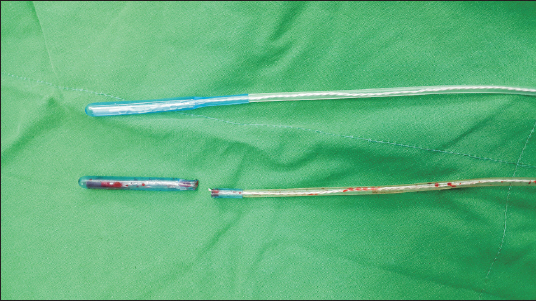Anesth Pain Med.
2018 Oct;13(4):415-418. 10.17085/apm.2018.13.4.415.
Accidental cut of esophageal temperature probe during lobectomy for lung cancer: A case report
- Affiliations
-
- 1Department of Thoracic and Cardiovascular Surgery, Yeungnam University College of Medicine, Daegu, Korea.
- 2Department of Anesthesiology and Pain Medicine, Yeungnam University College of Medicine, Daegu, Korea. apsj0718@naver.com
- KMID: 2436001
- DOI: http://doi.org/10.17085/apm.2018.13.4.415
Abstract
- Adequate maintenance of body temperature during general anesthesia is necessary for safety. Generally, esophageal temperature probe is commonly used in practice for measuring core temperature because of its reliability and feasibility. Proper placement of esophageal temperature probe is important to avoid complications. In this case report, we describe our experience with a patient undergoing lobectomy of the lung in whom the esophageal temperature probe that was misplaced into the right intermediate bronchus was accidentally cut. This case highlights the need to carefully assess correct position of the temperature probe, especially in patients undergoing one-lung ventilation.
Keyword
Figure
Cited by 1 articles
-
Comparison of upper and lower body forced air blanket to prevent perioperative hypothermia in patients who underwent spinal surgery in prone position: a randomized controlled trial
Jae Hwa Yoo, Si Young Ok, Sang Ho Kim, Ji Won Chung, Sun Young Park, Mun Gyu Kim, Ho Bum Cho, Sang Hoon Song, Yun Jeong Choi, Hyun Ju Kim, Hong Chul Oh
Korean J Anesthesiol. 2022;75(1):37-46. doi: 10.4097/kja.21087.
Reference
-
REFERENCE
1. Kurz A, Sessler DI, Lenhardt R. Perioperative normothermia to reduce the incidence of surgical-wound infection and shorten hospitalization. Study of Wound Infection and Temperature Group. N Engl J Med. 1996; 334:1209–15. DOI: 10.1056/NEJM199605093341901. PMID: 8606715.2. Winkler M, Akça O, Birkenberg B, Hetz H, Scheck T, Arkiliç CF, et al. Aggressive warming reduces blood loss during hip arthroplasty. Anesth Analg. 2000; 91:978–84. DOI: 10.1097/00000539-200010000-00039. PMID: 11004060.3. Lenhardt R, Marker E, Goll V, Tschernich H, Kurz A, Sessler DI, et al. Mild intraoperative hypothermia prolongs postanesthetic recovery. Anesthesiology. 1997; 87:1318–23. DOI: 10.1097/00000542-199712000-00009. PMID: 9416715.4. Insler SR, Sessler DI. Perioperative thermoregulation and temperature monitoring. Anesthesiol Clin. 2006; 24:823–37. DOI: 10.1016/j.atc.2006.09.001.5. Kaufman RD. Relationship between esophageal temperature gradient and heart and lung sounds heard by esophageal stethoscope. Anesth Analg. 1987; 66:1046–8. DOI: 10.1213/00000539-198710000-00029. PMID: 3631570.6. Liu SK, Chiang YY, Poon KS, Wen YR, Li CY, Liu YF, et al. Thoracotomy for lung lesion does not affect the accuracy of esophageal temperature. Acta Anaesthesiol Taiwan. 2013; 51:116–9. DOI: 10.1016/j.aat.2013.09.003. PMID: 24148740.7. Sanders JC. Deep positioning of an esophageal temperature probe may lead to overestimation of core body temperature during laparoscopic Nissen fundoplication in infants. Paediatr Anaesth. 2005; 15:351–2. DOI: 10.1111/j.1460-9592.2005.01595.x. PMID: 15787932.8. Stein B, Mack PF. Bronchospasm due to malpositioned esophageal temperature probe. Anesth Analg. 2003; 97:920–1. DOI: 10.1213/01.ANE.0000074664.12395.83. PMID: 12933435.9. Pickard WA, Reid L. Hypoxia caused by an esophageal stethoscope. Anesthesiology. 1986; 65:534–6. DOI: 10.1097/00000542-198611000-00018.10. Sessler DI. Temperature monitoring and perioperative thermoregulation. Anesthesiology. 2008; 109:318–38. DOI: 10.1097/ALN.0b013e31817f6d76. PMID: 18648241. PMCID: PMC2614355.11. Stone JG, Young WL, Smith CR, Solomon RA, Wald A, Ostapkovich N, et al. Do standard monitoring sites reflect true brain temperature when profound hypothermia is rapidly induced and reversed? Anesthesiology. 1995; 82:344–51. DOI: 10.1097/00000542-199502000-00004. PMID: 7856892.12. Lee J, Lim H, Son KG, Ko S. Optimal nasopharyngeal temperature probe placement. Anesth Analg. 2014; 119:875–9. DOI: 10.1213/ANE.0000000000000361. PMID: 25025586.13. Mekjavic IB, Morrison JB, Brengelmann GL. Construction and position verification of a thermocouple esophageal temperature probe. IEEE Trans Biomed Eng. 1984; 31:486–8. DOI: 10.1109/TBME.1984.325421. PMID: 6735424.14. Whitby JD, Dunkin LJ. Temperature differences in the oesophagus. The effects of intubation and ventilation. Br J Anaesth. 1969; 41:615–8. DOI: 10.1093/bja/41.7.615.15. Mekjavić IB, Rempel ME. Determination of esophageal probe insertion length based on standing and sitting height. J Appl Physiol (1985). 1990; 69:376–9. DOI: 10.1152/jappl.1990.69.1.376.
- Full Text Links
- Actions
-
Cited
- CITED
-
- Close
- Share
- Similar articles
-
- 8MHz RF Capacitive Heating on Rabbit Lung
- Robot-Assisted Thoracic Surgery in Non-small Cell Lung Cancer
- Synchronous Double Cancer of the Esophagus and Lung: Two case report
- Video-assisted thoracoscopic lobectomy for lung cancer
- One Lung Ventilation Using a Univent(R) Tube in a Patient with Permenant Tracheostomy after Total Laryngectomy: A case report


